Article
By the Numbers
The NPS employed few women and even fewer people of color from its founding in 1916 through the early 1960s. Not surprisingly, early park-specific data reflects a predominantly white male workforce. For example, Yellowstone National Park had 121 permanent and temporary employees in 1925. Of those, just nine (7%) were women. No other minorities have been identified. Of the women, four were clerks, three were telephone operators, and two were temporary park rangers. Those early demographic trends continued for decades. Beginning with the Kennedy administration, just before the Civil Rights Act of 1964, diversifying the workforce became an NPS objective. So almost 60 years later, how are we doing?
Sources and Limits of Available Data
Consolidated data about the number of men and women or other minorities working across the NPS is hard to find for much of the bureau’s history. Only four reasonably complete data sets for permanent employees have been found to date, spanning a 45-year period.
The earliest large data sets available are from 1975, 1976, and 1977. Those years may not be the most representative of general trends, as the NPS hired more employees for the US Bicentennial celebrations. The data includes total number of employees divided by gender, grade, series, and minority status. The data set that distinguishes grades, gender, and race together are only described as “non-minority” or “minority.” It also doesn’t break out the specific racial data by gender. Another problem with the way the 1970s data was reported is that the number of Hispanic employees was determined by “Spanish-sounding names.” Because of these discrepancies, most of the early data can’t be directly compared to more recent information. Where it can be, only the 1975 data is used, as it is the earliest available.
The 1991 data was extracted from the report Workforce Profile of Women in the National Park Service prepared by Richard Cripe. The NPS Office of Equal Opportunity Programs supplied data for 2010 and 2020. The raw data used to create the charts and graphs in this section is archived at the NPS History Collection.
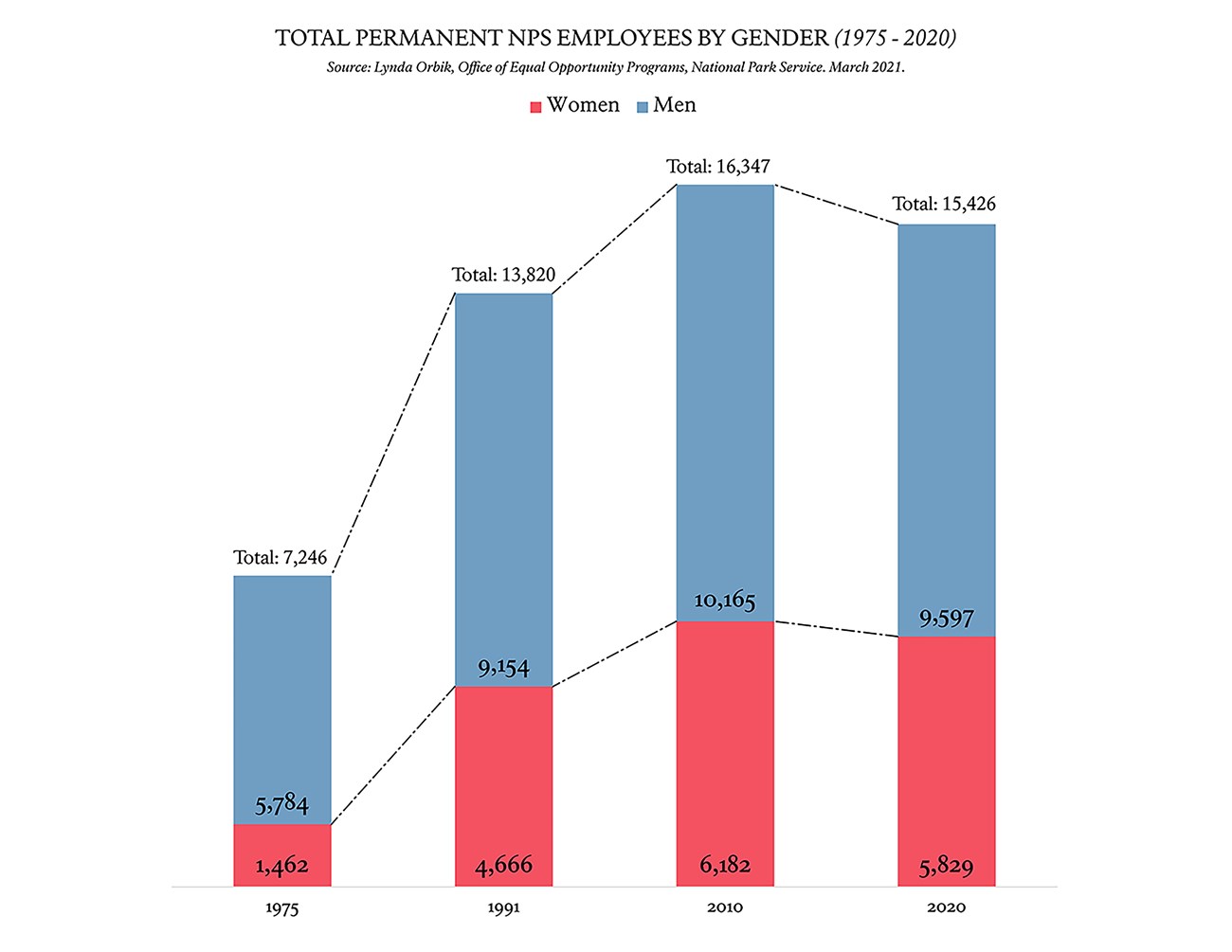
The Big Picture
Throughout NPS history, men have outnumbered women in the workforce. In 2020, women were 37.8 percent of the workforce but 50.8 percent of the American population. Available data provides interesting trends leading up to 2020.
The largest gains of female employees occurred between 1975 and 1991, when the number increased by 17 percent. There was a less dramatic increase from 1991 to 2010, but the number of permanent women employees fell from 2010 to 2020.
Chart 1. Bar Chart. Compares the number of permanent NPS women employees to men employees. The number of men consistently exceeds that of women. In 1975, there are almost four times as many men as women. The number of women increases considerably from 1975 to 1991. A smaller increase continues to 2010 but then the slight decrease in both men and women overall.
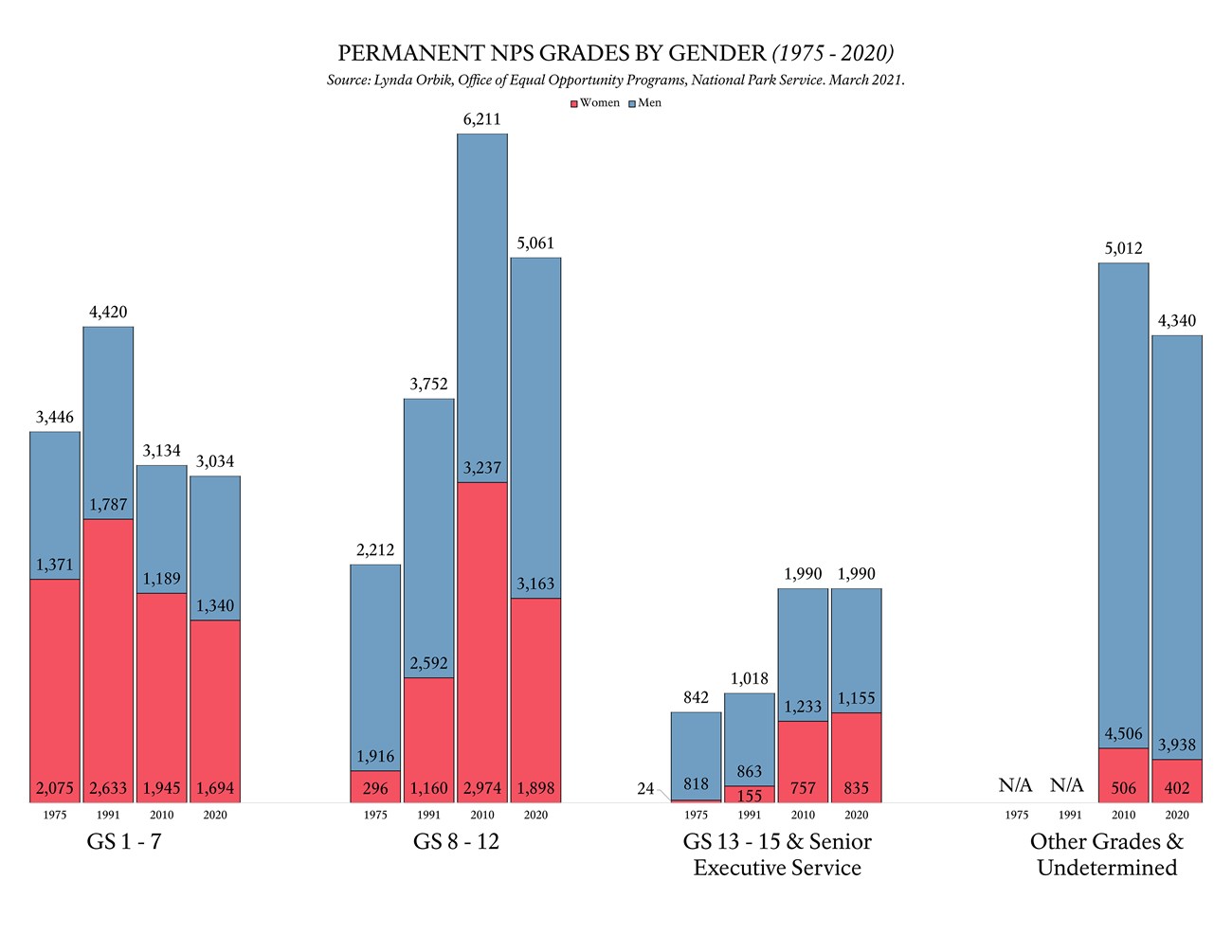
Jobs by Gender
While the total number of women working for the NPS is important, understanding their relative positions with the bureau sheds further light on issues of inequality. The data shows that there are more women than men in lower paid positions across the board.
A 1974 memo reports that there were five women park managers in 1972. By 1974 that number increased to 12 park managers. Although the number of women in higher-graded positions increased more noticeably beginning in 1991, men still exceed women, particularly at the management and executive levels.
Chart 2. Bar Chart. Data shows pay grades by gender for years 1975, 1991, 2010, and 2020. Pay grades are grouped by series 1-7, 8-12, 12-15 and Senior Executive Service, and Other Grades and Undetermined. Women outnumber men only in grades 1-7, which are the lowest paid jobs, for all years. Although women have made gains in getting higher paid jobs since 1975, men still dominate the higher paying jobs, including those at the executive levels.
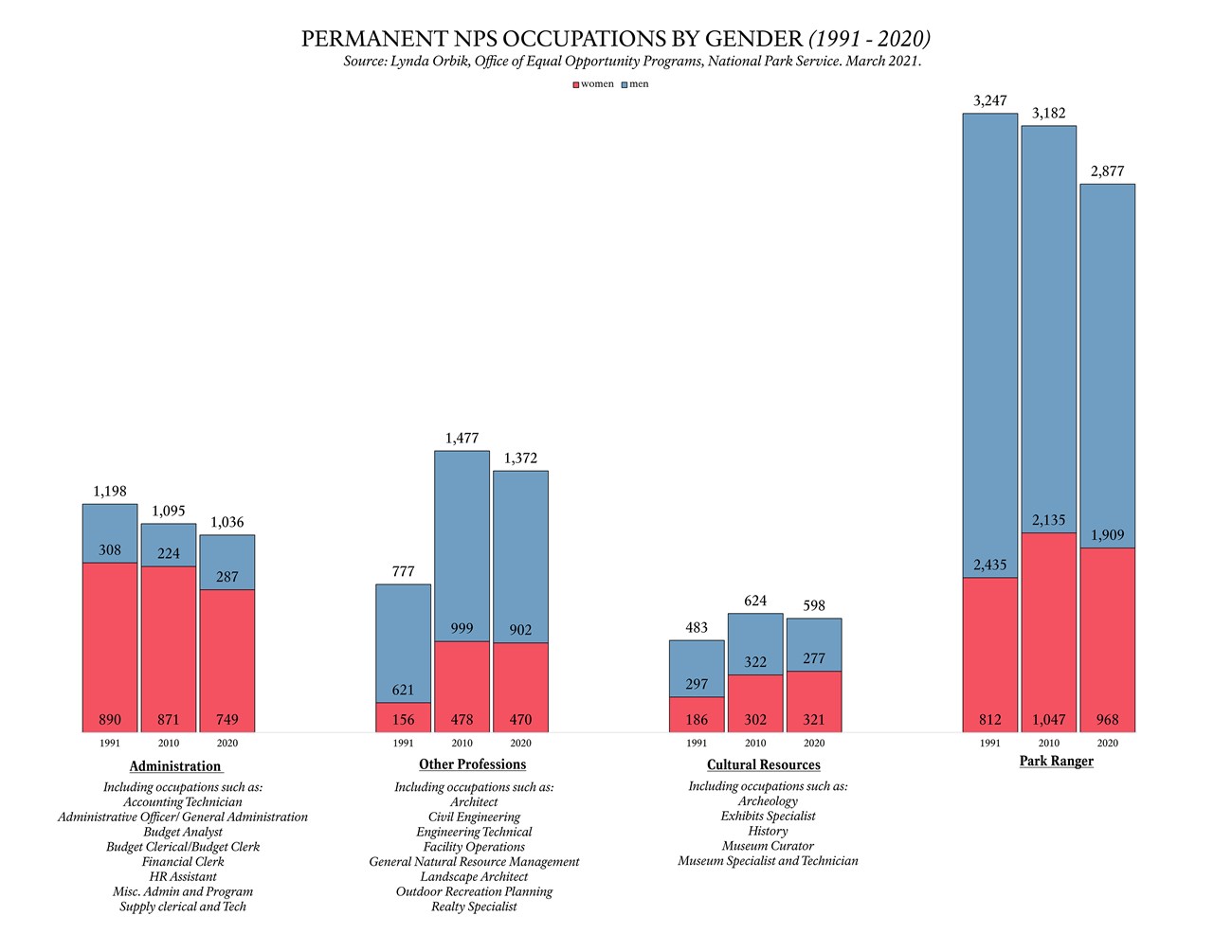
The data can be further broken down by career field. There are only two areas where women outnumber men. It’s not surprising that the careers where women represent the majority of employees are those in administration, including clerks, budget analysts, and administrative officers. The second area reflects recent gains for women in cultural resources management.
Given the NPS’s history of excluding women from ranger positions, it’s also not surprising that men vastly outnumber women in that career field. In a 1974 memorandum, Jeanetta Foreman, the Federal Women’s Program Coordinator, wrote that “[the NPS had] 57 permanent women Park Rangers in the service, compared to 46 as of December 1972.” That figured increased to 812 in 1991. Although numbers have increased since 1991, today there are fewer women rangers than in 2010. Women have gained ground in facilities management and related fields since 1991, but they still have less than half of those jobs.
Chart 3. Bar Chart. Data represents occupations by gender for 1991, 2010, and 2020. The categories used are administration, other professions ( which includes facilities management, engineering, and natural resource management), cultural resources, and park ranger. Across all years, women outnumber men dramatically in administration positions. There is less of a difference in cultural resources and, in fact, there were more women than men in cultural resources jobs in 2020. Park ranger positions and other professions continue to have more men than women for all years with available data.
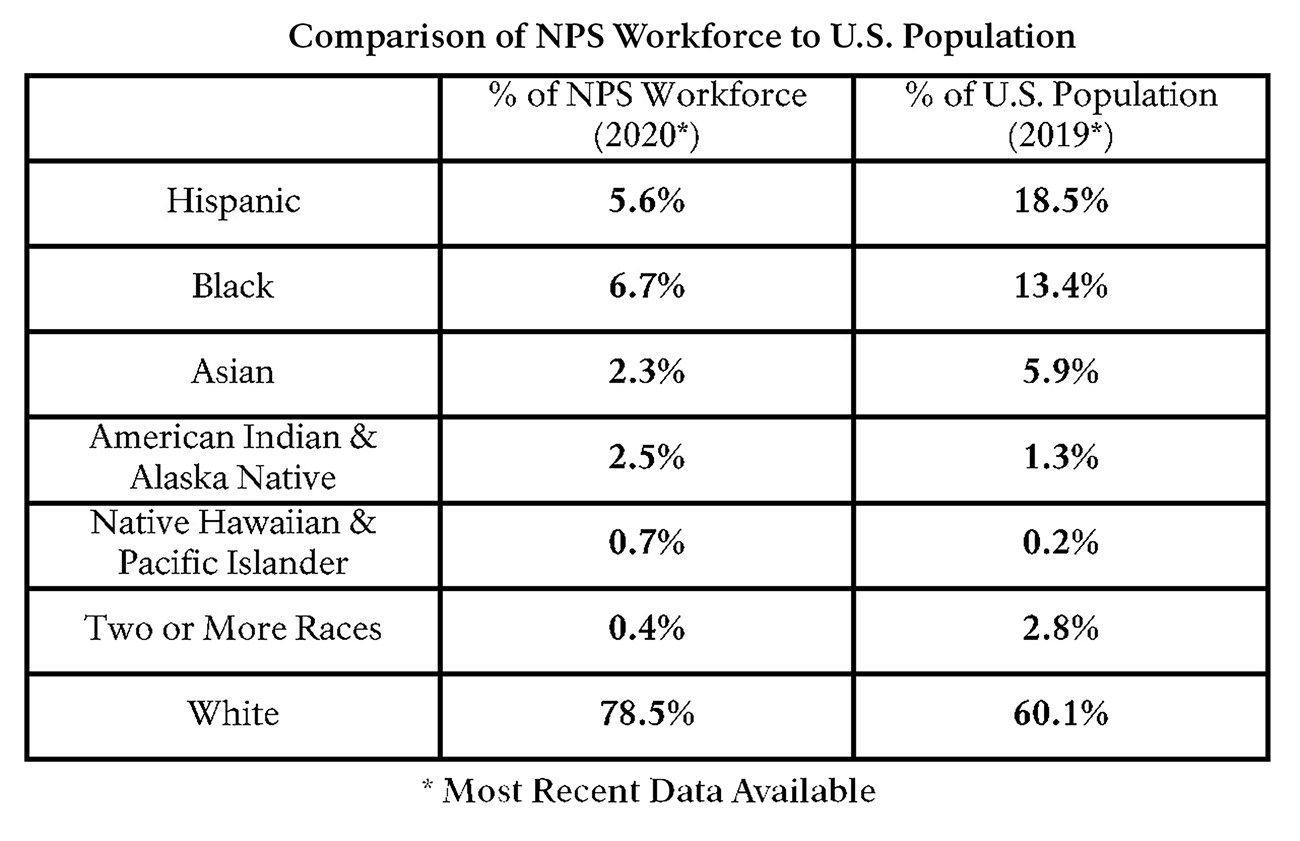
Diversity Deficit
Due to differences in data collection, the 1975 diversity data is charted separately from the other three data sets. In 1975, the NPS had 7,246 permanent employees and that workforce was overwhelming Caucasian. White women only accounted for 20 percent of that total, as men continued to get the vast majority of jobs.
Overall, however, only 17 percent of the workforce were minority men and women. Minority men still did better than minority women, however, as only 4.5 percent of jobs were held by women of color. Ten years after the Civil Rights Act of 1964, the NPS still had both gender and diversity issues. Those issues weren’t improving by 1978 when a new class of 81 intake trainees was hired. White men received the vast majority of the placements (53), followed by white women (22). Only six positions went to minority candidates (four women and two men).
The NPS continues to work on improving the diversity of its workforce as representative of the American population. However, in 2020 Whites still accounted for 79 percent of full-time permanent employees, down only 4 percent in 45 years. The number of women employees increased to 38 percent, but that still represents significantly less than the more than 50 percent of women of the US population.
Table 1. The data compares the diversity of the NPS workforce in 2020 with 2019 data for the US population. The NPS has about 18 percent more white employees than is represented in the population. Hispanic employees only represent 5.6 percent of the workforce but 18.5 percent of the population. For Blacks, the figures are 6.7 percent and 13.4 percent, respectively. Asians are also under represented at 2.3 percent compared to 5.9 percent in the population. American Indians, Alaska Natives, Native Hawai’ians and Pacific Islanders exceed their representation in the larger population, but their numbers remain very small.
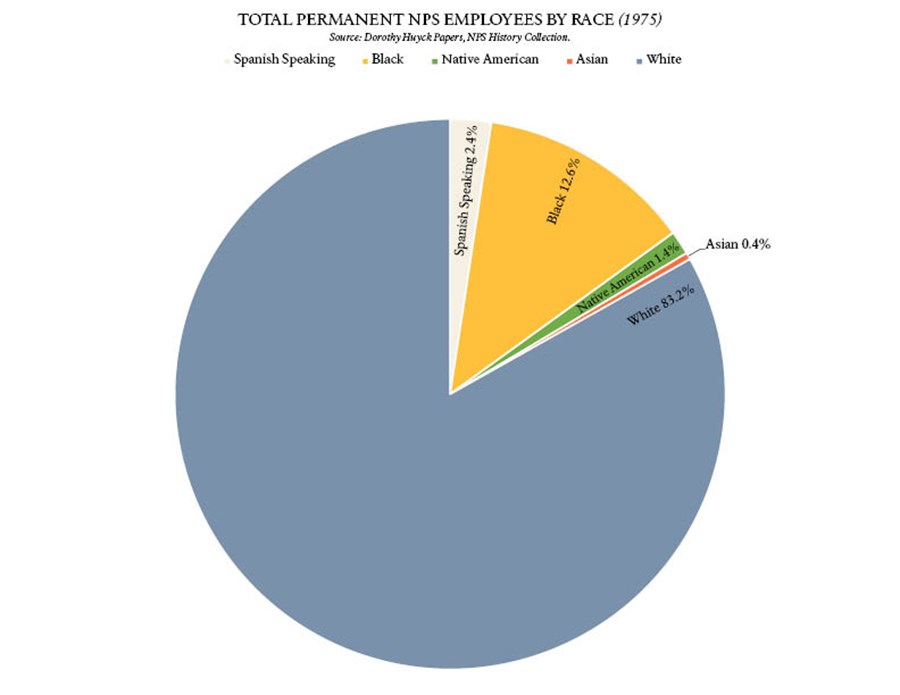
Today, only Native Americans and Alaska Natives and Native Hawaiian and Pacific Islanders are represented at greater levels than their overall percentage of the US population, with 2.5 percent in the NPS compared to 1.3 percent overall for Native Americans and Alaska Natives, and 0.7 percent in the NPS compared to 0.2 percent overall for Native Hawaiian and Pacific Islanders. Even these figures are still remarkedly low, particularly given the number of NPS sites with historical, cultural, and religious significance to Native Americans, Alaskan Natives, Native Hawaiians, and Pacific Islanders. Other minority groups remain significantly underrepresented.
Although men outnumber women overall, it is also useful to understand how diverse (or not) women on the workforce are. Mirroring the gender disparity, women employees are overwhelmingly white within their own categories. Between 2010 and 2020, the NPS has seen a very small increase in minority representation. However, this growth was only a 2 percent difference. No matter how race distribution is broken down, white employees consistently outnumber employees of color.
Chart 4. Pie Chart. Data represents the racial background for permanent NPS employees in 1975 only. Whites represent 83.2 percent while Blacks are 12 percent. Native American are 1.4 percent of the workforce and Asians only 0.4 percent. The data for Hispanic individuals was recorded as “Spanish Speaking” and may not be accurate but the small number (2.4 percent) is certainly telling.
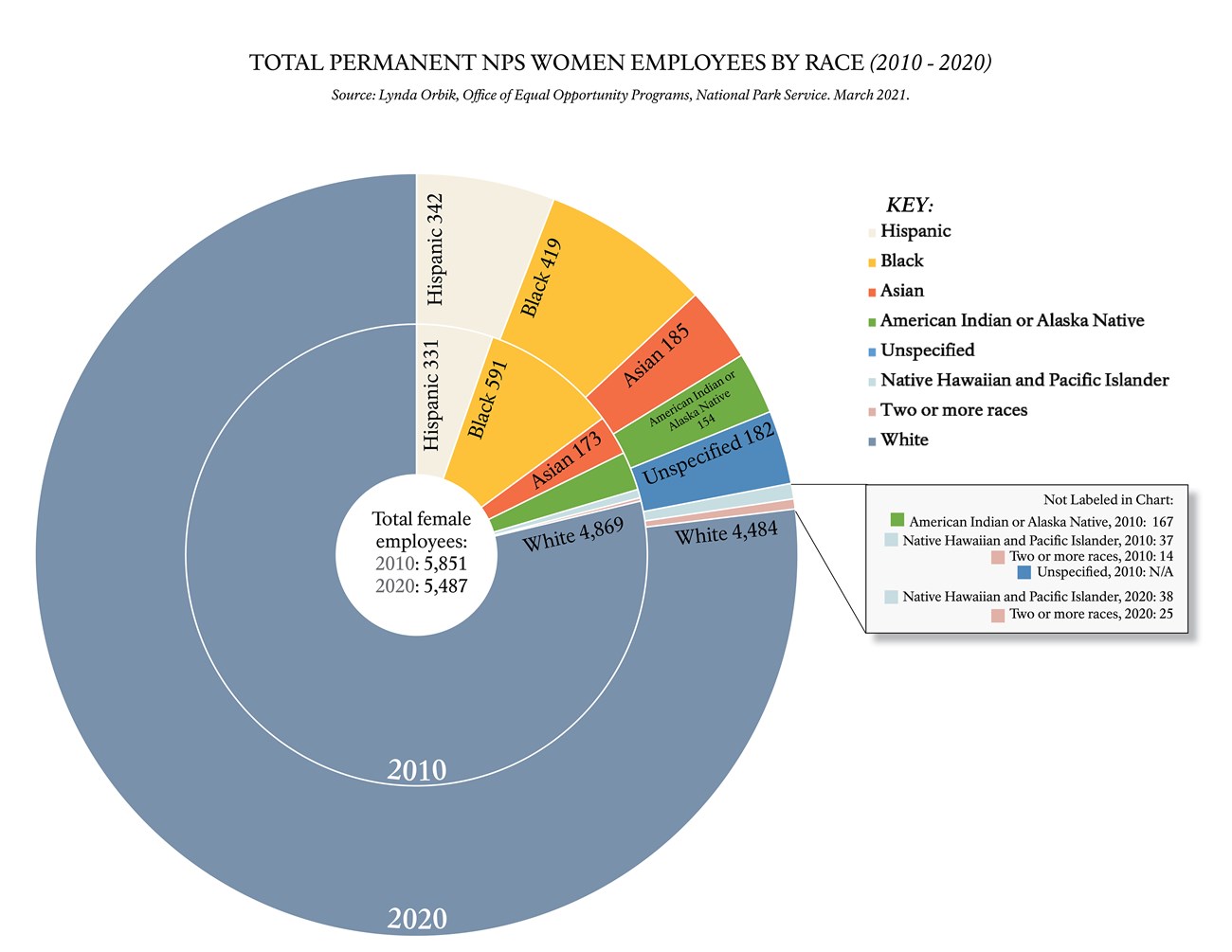
Chart 5. Pie Chart. Data is in two concentric rings of chart and compares the races of women in the NPS workforce for both years. The outer ring has the 2020 data and the inner ring has the 2010 data. There were 5,851 permanent women employees in 2010 and 5,487 in 2020. Whites make over 75% of the workforce both years, with slightly more in 2010 when there were more women workers. The number of Hispanic and Asian women increased slightly, whereas Black women, Native Americans, and Alaska Natives decreased from 2010 to 2020. In addition, more individuals didn’t specify their race in the 2020 data.
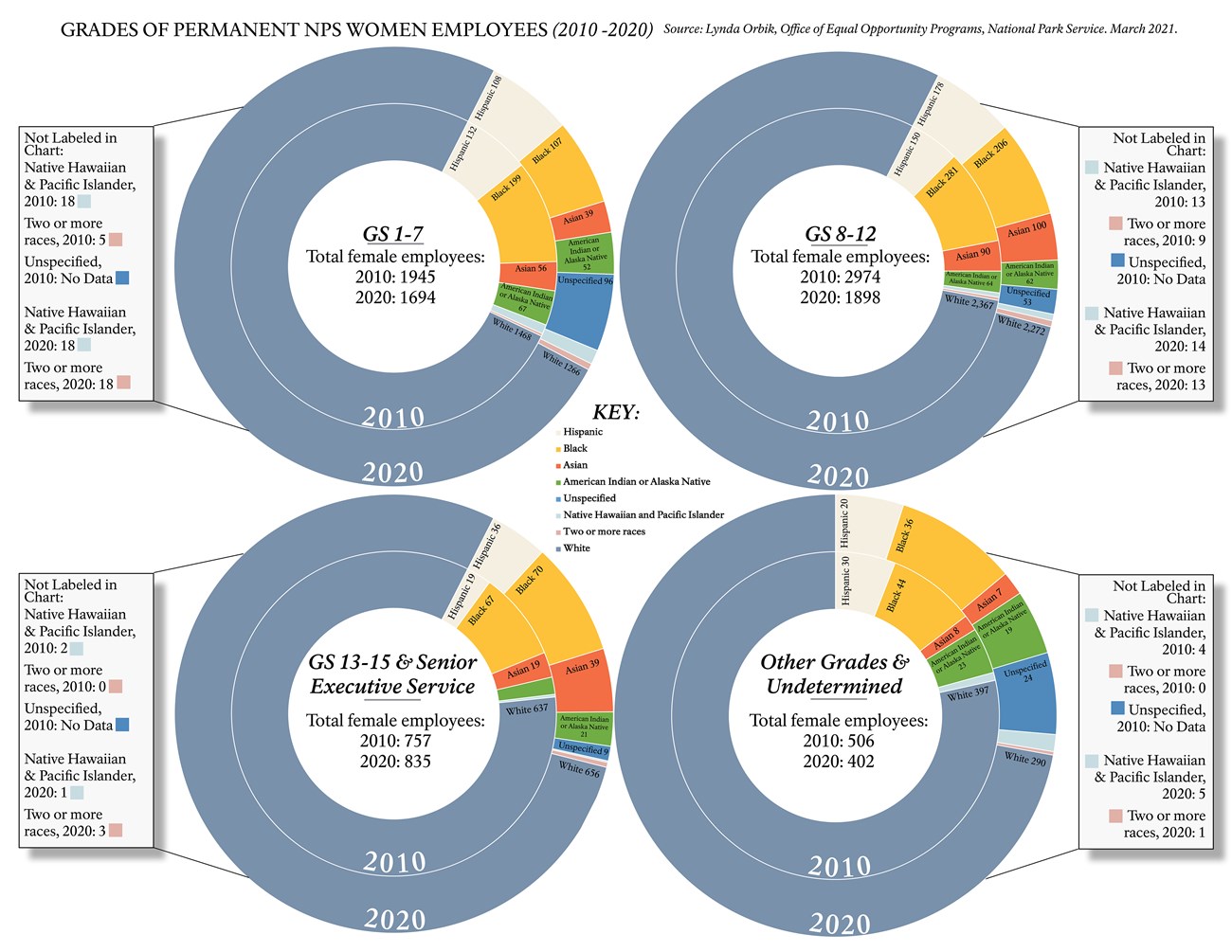
Career Women
The most recent data reveals trends in careers as well. Not surprisingly, white women have the overwhelming majority of jobs held by women at all grade (salary) levels for both 2010 and 2020. People of color have more careers in administrative positions than other fields, roughly 28 percent in both 2010 and 2020. Comparatively, minority women hold around 9–11 percent of positions in cultural resource fields.
Chart 6. Four Pie Charts. Each chart contains data by job grade level (representing salary ranges) from 2010 and 2020. Data in each chart is in two concentric rings and compares the women in the NPS workforce by race.
In the chart for grades GS 1-7 (the lowest salaries), the total number of women was 1,945 in 2010 and 1,694 in 2020. With fewer women hired overall, representations declined somewhat. However, White women still hold the majority of jobs. Black women have the greatest decline from 2010 (199) to 2020 (107).
In the chart for grades 8-12, the total number of women was 2,974 in 2010 and 1,898 in 2020, demonstrating a marked decrease in women in these higher paying jobs for all women. White women also hold most jobs at these levels. Although Hispanic and Asian women see a small increase, Black women lose positions from 2010 (281) to 2020 (206).
In the chart for grades 13-15 and senior executive service, the total number of women was 757 in 2010 and 835 in 2020, demonstrating a slight increase in women in executive and leadership positions. This is one area where minority women have made gains from 2010 to 2020. The number of Hispanic women increased from 19 to 39, Black women from 67 to 70, and Asian women from 19 to 39, with 21 Native American or Alaska Native women in these senior positions in 2020.
The last chart uses data from other grades or where grades were undetermined. The total for 2010 was 506 women and 402 in 2020. This decrease may be just a reflection of changing data quality rather than an actual decrease. White women continue to hold most of the positions. All other races lost positions, although their overall numbers are so low the declines are arguably more significant.
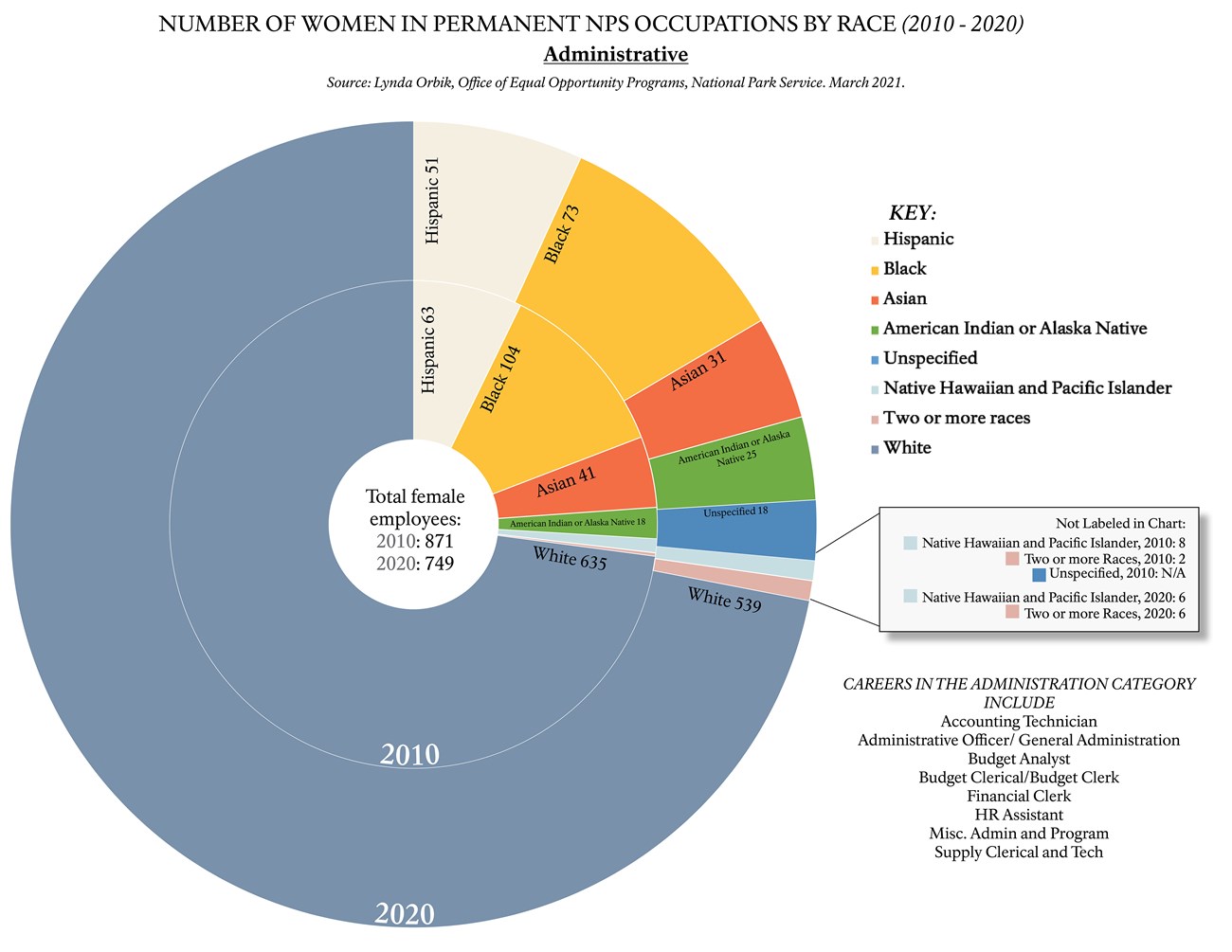
A Long Way to Go
The 1975 graphs showing the racial makeup of the permanent work force look striking similar to those from 2010 and 2020, an indication that the NPS has not made significant gains in improving the diversity of its workforce. Although women in general are not represented in the workforce to the same degree as they are present in the US population, it’s minority women (and men, of course, but this is a Portfolio about women) who are vastly underrepresented. Overall, minority women consistently occupy between 10 and 25 percent of the NPS labor force, although they are about 48 percent of the national labor force. In spite of efforts over the past few decades, the NPS still has a long way to go in achieving racial and gender equality among its workforce.
Chart 7. Pie Chart. Data is in two concentric rings of chart and compares the number of women in administrative positions in 2010 and 2020. The total number of women in these jobs decreased from 871 in 2010 to 749 in 2020 and decreases are reflected in most categories. White women make about 70 percent of the women in both years, although there was a small decrease in their numbers in 2020. Hispanics, Blacks, Asians, Native Americans or Alaska Natives, Native Hawai’ians and Pacific Islanders, and those of two or more races or unspecified are all present only in the single digits.
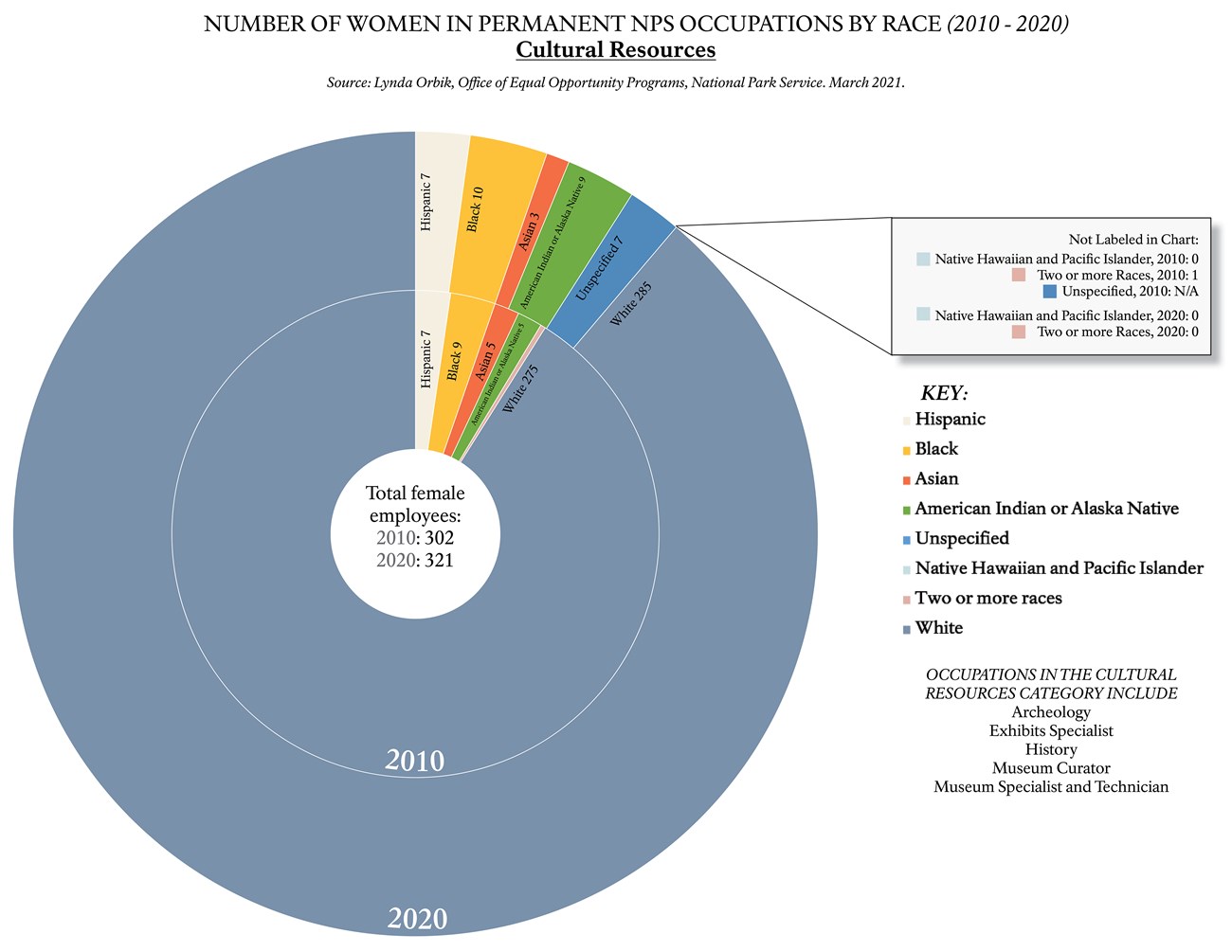
Chart 8. Pie Chart. Data is in two concentric rings of chart and compares the number of women in cultural resources positions in 2010 and 2020. The total number of women employees was 302 in 2010 and 321 in 2020. White women make up over 85 percent of the women in both years, although there was a small decrease in their numbers in 2020. Black, Hispanic, and Asian women were fairly consistent in numbers. However, American Indian and Alaska Native numbers actually increased in 2020. In addition, more individuals didn’t specify their race in the 2020 data.
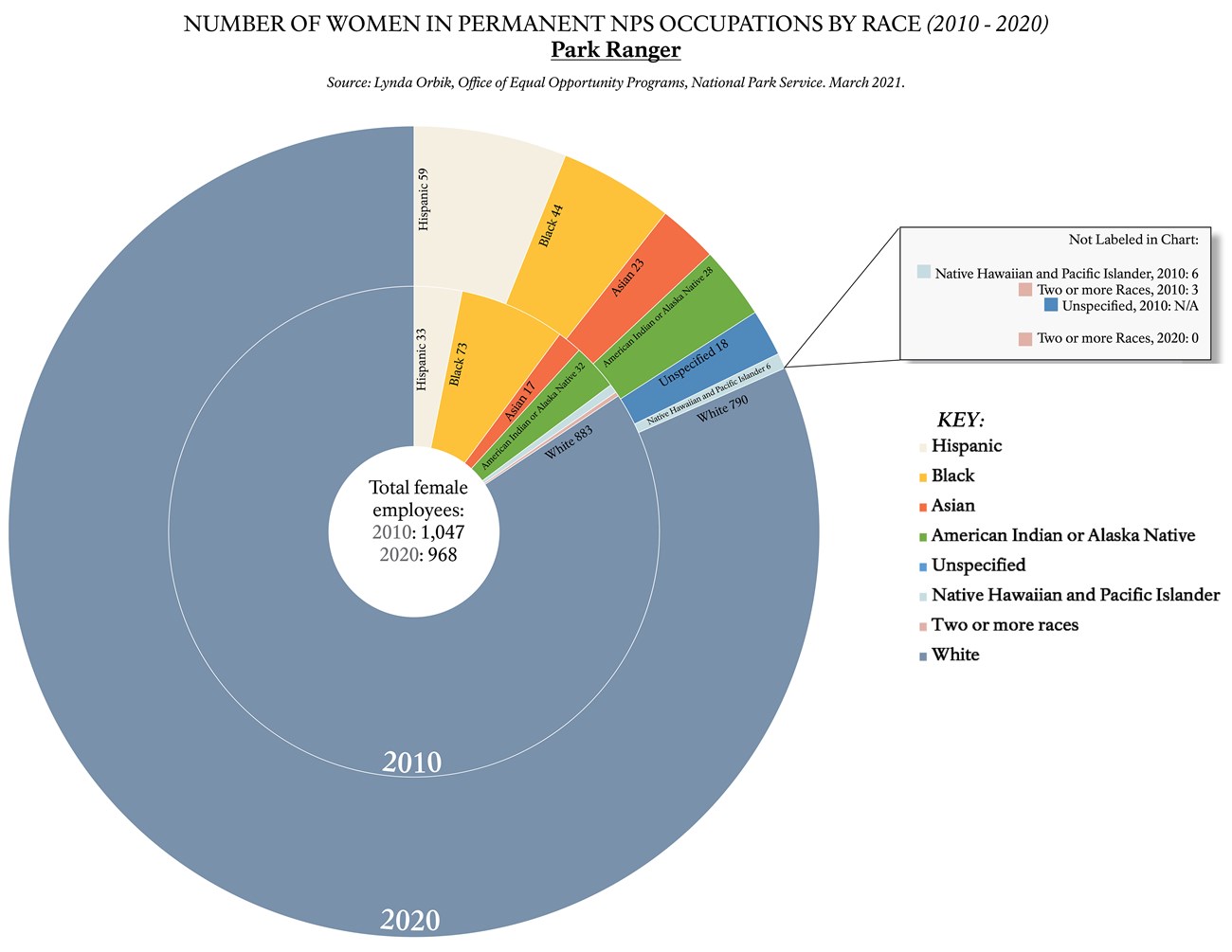
Chart 9. Pie Chart. Data is in two concentric rings of chart and compares the number of women in park ranger positions in 2010 and 2020. The total number of women employees was 1,047 in 2010 and 968 in 2020. White women hold about 80 percent of the positions. There was a marked increase in Hispanic women from 2010 to 2020 when the increased from 33 to 59. Asian women also saw a small gain. However, the number of Black women rangers decreased significantly from 73 to 44. All women of color were present in single-digit figures only.
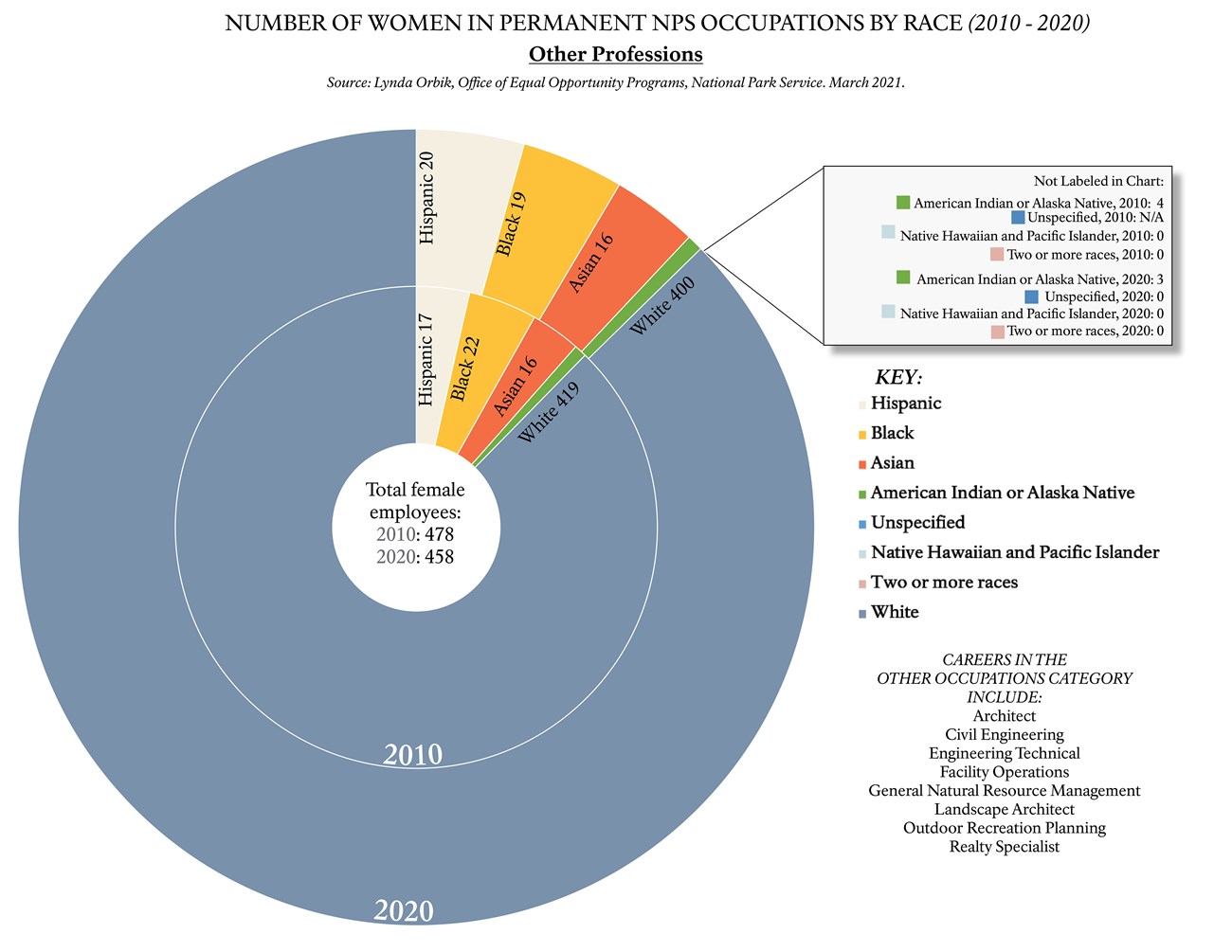
Chart 10. Pie Chart. Data is in two concentric rings of chart and compares the number of women in other professions in 2010 and 2020. The total number of permanent women employees was 478 in 2010 and 458 in 2020. White women hold about 85% of the positions. Although the number of Asian women remained the same (16), the number of Hispanic, Black, and Native American or Alaska Native women all decreased slightly. The numbers of minority women are incredibly small with 22 Black women in 2010 and 19 in 2020 representing the highest figures for any group. There are not Native Hawaiians or Pacific Islands represented in either year.
